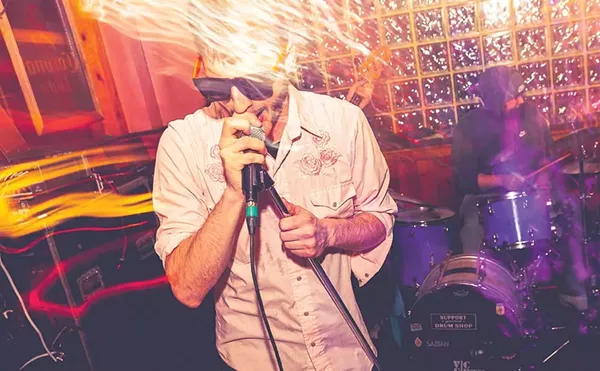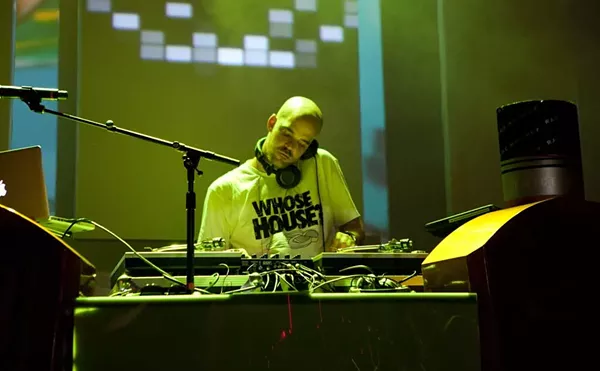Your home movies: Mostly relatives looking stiff as if having trouble making the transition from still photos, waving weakly, waiting for a cue to walk into the shot as unnaturally as possible.
Ivan Kral's home movies: Debbie Harry of Blondie on a roof posing for her first publicity shots, the Ramones in their first weeks at CBGB — which, at the time, had less graffiti and a poster of vaudevillian Eva Tanguay on its walls — Talking Heads performing one of their earliest sets as a trio and the New York Dolls performing one of their last hometown sets at the Beacon Theatre.
In between playing guitar in a pre-record-deal, 1974 version of Blondie and his pivotal role in the Patti Smith Group in 1975 (and later with Iggy Pop), Czech musician-songwriter Ivan Kral took 8 mm films of his friends performing at clubs for a handful of people, an hour's worth that forms the basis of The Blank Generation, a fascinating week-to-week living history of punk's earliest days.
"It wasn't meant to be more than home movies of the friends I made at the clubs," Kral says. "I didn't have a citizenship at the time. During that era, my dad was in pretty bad shape; he spoke against the Invasion in 1968 when Eastern Bloc forces came to Prague. I didn't know if I was going to be deported back to Prague, so I thought naively that I'm gonna share my travels and thoughts and who I met with my friends in Prague.
"And also, when you play or you have time between two gigs at CBGBs," Kral continues, "you have so much time so, what else? You're going to read a book or a paper? I always had a camera with me."
Kral not only caught seminal early sets but also some real-life drama, like Blondie working as a group to push Debbie Harry's car down a Bowery street.
"That was her car full of unpaid parking tickets," Kral laughs. "A lot of times it wouldn't start. Debbie was the only one who had a car in the band, we had to push it and start it."
One aesthetic that takes you from the modern world to this bygone era was that none of Kral's footage had sound. "Super 8 sound was very expensive at the time. It was around 1979 when I started shooting with sound," he says, noting its major imperfection of recording the whirring sound of the camera itself. "Sometimes I would give to the performers and they would say, 'Just shoot backstage and forget filming the performance.'"
But Kral sidestepped creating the first punk-rock silent movie (Birth of a Punk Nation, anyone?) by adding audio from cassette demos he collected off the groups at the time.
"It was so easy because we were all friends. You would go after a gig to Talking Heads and say, 'Do you guys have any tapes?' and they would say, 'Oh, yeah, here's our demo.' Then I would go to Dee Dee and Joey and say, 'I really like "I Don't Care." Can I use that song?' And they'd say, 'Yeah, here's a cassette. And the same with Debbie Harry or Tom Verlaine. I had all these cassettes I put on reel-to-reel then transferred them onto magnetic and optical audio — haphazardly just put it in there. It was a silent film so it is what it is. A lot of it is in mono with tape hiss, that's what it was before people went to professional studios and recorded properly."
Unlike most musical movements where hundreds of bands seize a look or sound, especially Britain's regimented interpretation of American punk, the first bands to play CBGB were only characterized by their DIY spirit and lack of an audience — besides each other and their girlfriends.
The gutter poetry of Patti Smith may have found a kindred spirit in Television's Tom Verlaine's impressionistic prose (they are shown sharing a stage at some early juncture), but sonically they're worlds apart. Ditto for the Ramones' and Talking Heads' respective versions of minimalism. Debbie Harry and Robert Gordon may have shared nostalgia for bygone rock and pop, but the similarities between Blondie and Tuff Darts are few and far between.
"We were all friendly and didn't try to imitate each other, every band was different," agrees Kral, whose camera also caught the moment this scene declared itself over. The last 15 minutes of the movie give way to a lot of forgotten bands and faces like Harry Toledo and the Miamis, bridge-and-tunnel bands heading nowhere.
The very last few feet of film you see is a sped-up silent movie of a New Year's party at CBGBs that looks like one of those old Hollywood studio movies where every major star is lunching together. It would be hard to get Tom Verlaine, Johnny Ramone, Chris Stein, David Byrne and Wayne County all under one roof ever again.
"I think that New Years' celebration ... that was probably the last time it was like that," says Kral, who filmed at a slow speed because he was running out of film, an effect which accentuates Patti Smith and Tom Verlaine's inner silent film star expressiveness.
"After that, Patti got signed and Blondie got signed, and then all the local bands from Long Island, Queens, Brooklyn and New Jersey, even, came to CBGBs. Before, there were not two bands and 20 people in the audience who couldn't care less. All of the sudden it was packed and there were bands going from 3 in the afternoon till 3 in the morning. It was kinda over by then. You were getting a lot of teeny bop, three-part harmony bands."
Kral says he now lives between "Michigan and Prague," with Ann Arbor his primary home base.
"It's private and close to the airport. It's a great scene too; I'm still wide-eyed even though I've been here almost 10 years. Meeting all the legendary players like Jim McCarty, Mitch Ryder ... the Rationals put their double CD together and I'm amazed by the writing. And there's a band that used to be with Kid Rock called Howling Diablos; they're an amazing band. Just overall, if you see a blues band or something and there's a bass player from Detroit Wheels."
The Blank Generation is the tip of the iceberg of what Kral has tucked away in a warehouse.
"We are going through boxes of footage," says the affable Czech. "There's so much that I didn't use or am still going to use.
Kral seems to prefer the mystery of film to the spoiling convenience of video. "The film was pretty expensive and you were never sure if you really put the brackets in properly, so you were never sure anything was gonna be on it when you'd get it back months later."
This special 35th anniversary showing of The Blank Generation at the Michigan Theater is a premiere of sorts, a remastered, digitized frame-by-frame, a crisp and clean version of a scene Joey Ramone remembered as, "Yeah, it was all cockroaches, man"
"Nobody was anybody then," Kral muses. "It's amazing to look at it 35 years later and say, 'Wait a minute! These guys happened. All of them!'"
Screens at 7 p.m. on Thursday, July 29, at the Michigan Theater, 603 E. Liberty St., Ann Arbor; 734-668-8463.
Serene Dominic writes about music for Metro Times. Send comments to [email protected]





